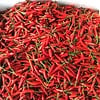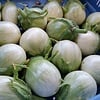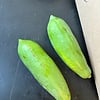Coriander Roots Thai ( 2x500 gram.) - 1kg.
Cilantro Roots Read more
Thais use the root of the Coriander (Cilantro) plant as a flavoring in soups and curry pastes. It may be difficult to find Coriander in the West with the roots still on. I found that in Asian groceries, or sometimes in Latin groceries you can find it with the root. Cut the root with about 1/2″ of green (like shown) and wash very very well before adding to the dish. To get even more flavor in a soup, bruise the root with a stone mortar & pestle first.
Storage: Store coriander in a glass filled with water inside the fridge. If stored this way, it should last 2 weeks or so. If it comes with a rubber band or twist tie around it, remove that first for longer shelf life. You can also freeze the roots for long term storage.
Description/Taste
Cilantro roots have a pure white central tap root that is covered in small hair-like rootlets which are typically are darker shade of tan. They have an aromatic, somewhat peppery flavor that is more pungent than the commonly used leaves. They possess a deep, earthy flavor akin to celergy root with hints of lemon and spice. The roots of younger plants are thin and tender, but larger roots become tough and bitter. Their woody texture and sharp flavor softens with cooking and even develops a mild sweetness.
Seasons/Availability
Cilantro roots are available year-round.
Current Facts
Cilantro, commonly called Coriander or Chinese parsley, is botanically known as Coriandrum sativum. It is an herbaceous annual in the family Apiaceae. While the leaves, seeds and flowers are often seen in cuisines around the world, the roots are rarely used outside of Thailand. There, they are used to give a rich cilantro-like flavor to marinaes, broths, stews and sauces. Cilantro’s unique flavor is adored by some yet despised by others. Aldehydes within the plant are similar to those found in some lotions and soaps, giving credit to the claims of the herb’s “soapy” character.
Nutritional Value
Cilantro root is has natural antibiotic qualities.
Applications
Young Cilantro roots may be stir fried and eaten with minimal cooking. The larger Cilantro roots must be cooked because of their coarse and chewy texture. They are best in applications involving a long gradual cooking process, such as the broths and stocks used in Thai cooking. They can stand up to long simmering times and high temperatures in ways that the delicate leaves cannot. The root's strong taste is tempered when slowly rendered with garlic, salt and Thai peppercorns. Cilantro roots pair well with ingredients such as carrots, scallion, tomato paste, coconut milk, citrus, ginger, kaffir lime leaves, galangal, lemongrass, chile peppers, chicken, lamb and goat.
Ethnic/Cultural Info
The leaves of Cilantro are widely used throughout Asia, India, North Africa and in Latin America where it is an integral ingredient in fresh salsas and sauces. Cilantro root is used mainly in Asia where it is one of the four main components of Thai seasoning pastes, along with garlic, salt and Thai peppercorns. It is essential to making an authentic Thai curry.
Geography/History
Cilantro is native to Southwest Asia and North Africa. Today it is cultivated in herb gardens around the world, but prefers climates with cool dry summers. It thrives in well drained soils with full sun to partial afternoon shade. It is a quick growing herb that is prone to bolting, and it quickly develops substantial root structures for a year-round harvest.



 vegetables
vegetables
 fruit
fruit
 chilli
chilli
 eggplant thai
eggplant thai
 NEW project - GREEN PAPAYA THAI.
NEW project - GREEN PAPAYA THAI.







